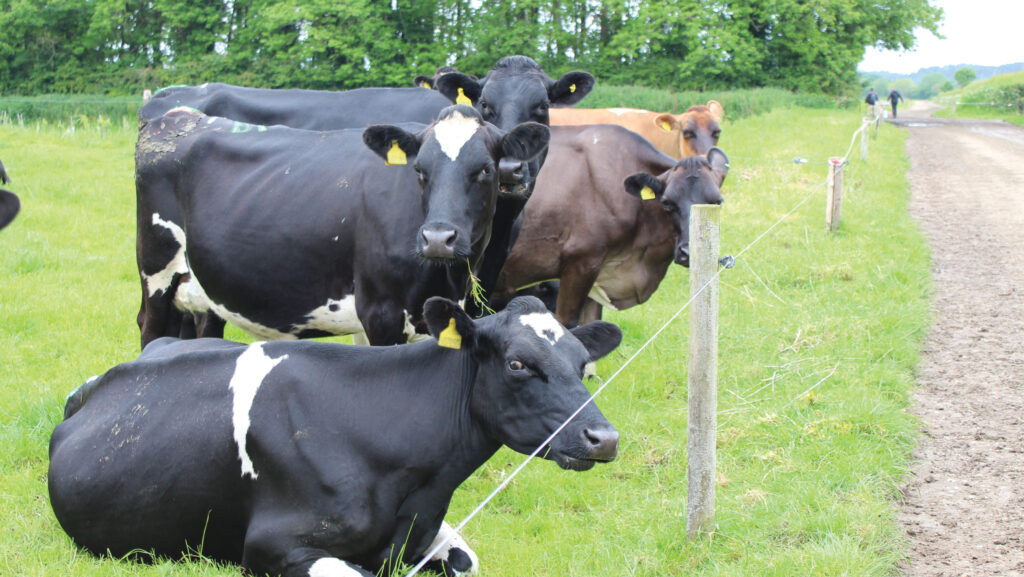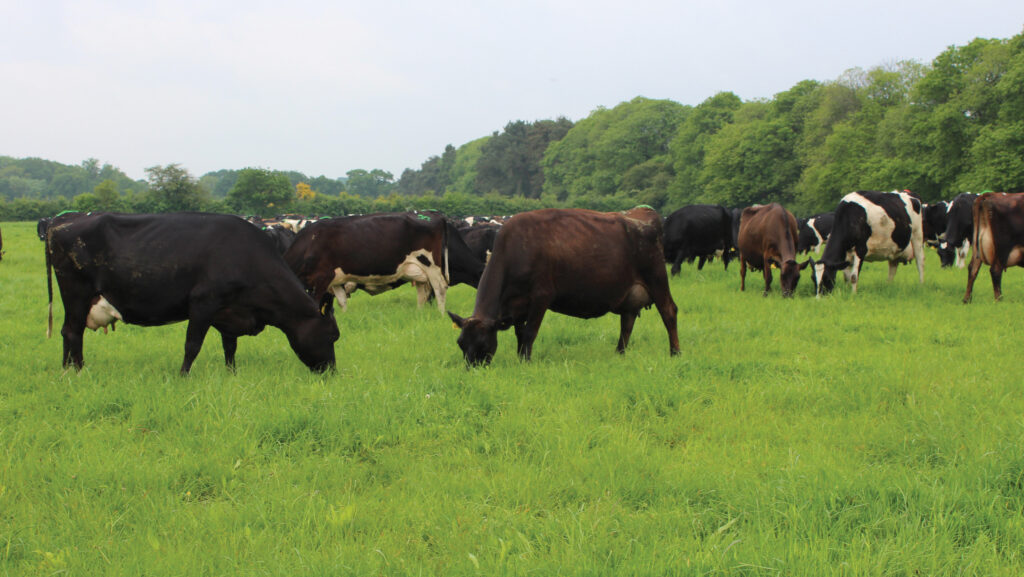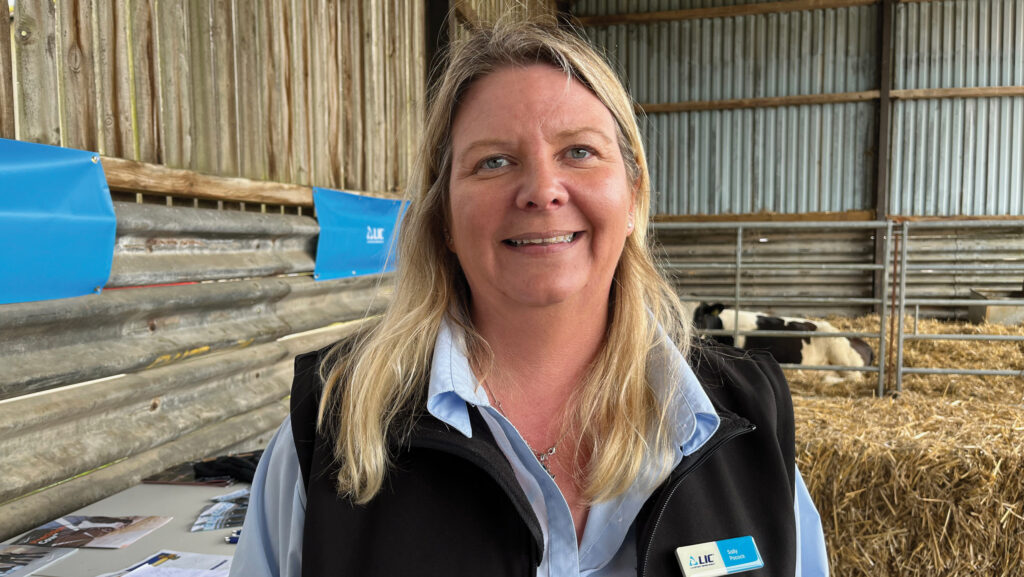3 ways Gold Cup winner is hitting production targets
 © Aly Balsom
© Aly Balsom The right cow for the system, optimising grass utilisation and feeding cows well are the main success factors for achieving top levels of milk solids and production from forage.
This is according to George Brown, who won the 2023 National Milk Records/Royal Association of British Dairy Farmers Gold Cup together with contract farming partner Hallam Mills.
See also: Why all herds could benefit from increased milk solids

George Brown © Aly Balsom
The herd of 600 crossbred cows at Bisterne Farms, near Ringwood in Hampshire, calves in autumn and spring blocks. For the year to April 2024 it averaged 5,991 litres a cow, with 3,373 litres from forage.
Cows are producing about 514kg milk solids (MS) a cow a year.
However, lower silage quality this year and a reduction in concentrate feeding following the lower winter milk prices have resulted in a drop in milk solids from 550kg, as well as milk yield.
Farm Facts: Bisterne Farms, Ringwood, Hampshire
- Estate owned by Hallam Mills and dairy run in a contract farming agreement with George Brown
- 1,500ha total
- 400 autumn calvers and 200 spring calvers, each calving in a six-week block
- Producing 5,991 litres a cow a year at 4.98% fat and 3.77% protein
- 500ha grassland, including 200ha on low-input river meadows, plus land for maize and fodder beet
- 180ha milking platform stocked at 3.33 cows/ha
- All replacement heifers produced from the autumn calving herd
- Autumn calvers on self-feed silage (50:50 grass and maize) in winter
- Spring calvers outwintered on fodder beet and dry silage or hay
- 1.4t concentrate a cow a year average
Speaking to Farmers Weekly at the Gold Cup Open Day, George said the aims of the business were unchanged.
“The target is, can we do 4,000 litres milk from forage and 550kg of milk solids? Doing both of those is hard,” he said.
In the long term, George has his sights on 600kg of milk solids a cow a year – something he thinks is doable, considering 25% of the herd is already surpassing this figure in 305 days.
To achieve these targets, along with a healthy, long-lived herd, George – who was the 2012 Farmers Weekly Farmers Apprentice – pays particular attention to three main management factors.
1. A focus on cow body condition
Feeding cows well, then monitoring and maintaining body condition are viewed as the drivers to manage a healthy, productive herd.
The team targets a body condition of 2.5-3 at calving and will routinely body-condition score to check the herd is on track.
Any cows below target three months before calving will be dried off, managed separately and fed on grass and fodder beet.
George is not afraid to feed well between calving and breeding to support fertility.
Spring and autumn calvers graze at different times during this period to manage demand on the platform and because there is not enough housing for the whole herd.
He says the spring calver “potentially has a tough gig” as she has grazed in February.
Consequently, she will be fed 5-6kg concentrate a day, housed and fed silage in the day, and graze at night.

© Aly Balsom
Autumn calvers are housed at night from September and fed 5-6kg of concentrate.
They graze in the daytime to a residual of 1,700kg dry matter (DM)/ha, rather than be pushed to 1,500kg DM/ha.
Vet Josh Swain at Synergy Farm Health says the Bisterne Farms team will look at rumen fill to assess if cows are full, residuals to monitor if cows are getting the right allocation of grass, and body condition as an indicator of longer-term trends of their nutritional status.
He explains: “Everything is related to body condition score and nutrition.
“Cows that hit target body condition and are well-fed in lactation will transition from a dry cow to a lactating cow well and not get issues.”
This is reflected in low disease incidence around calving. In the past 12 months, the herd averaged 1.1% retained foetal membranes, with fewer than 1% downer cows and 1.6% milk fevers.
2. The right cow for the system
Breeding decisions are focused on producing a cow that will use forage efficiently and produce a high volume of milk solids.
Bulls are chosen with milk solids of plus-80kg. Four New Zealand Friesians and one Kiwi-cross bull are selected for artificial insemination, with the Kiwi-cross bringing in Jersey genetics.
“We still believe in hybrid vigour, and a Jersey is good for efficiency and milk solids,” says George, who explains that all replacement heifers are bred from the top-performing autumn-calving cows, while bottom performers are put to beef.

Sally Pocock © Aly Balsom
Sally Pocock, national pasture sales manager for genetics specialist LIC, helps Bisterne Farms make informed breeding decisions.
To do this, she looks at a combination of milk-recording parameters to rank individuals. These include days in milk, milk solids and volume.
For example, she says, in a block-calving herd, cows should milk for 305 days and be dry for 60 days.
If one cow is milking for 320 days and another for 305 days, and they are producing the same total, the first is less efficient.
The level of milk solids produced by each cow by lactation is another useful breeding guide.
First-lactation animals should be producing 75% of the milk solids produced by cows in lactations three to eight, says Sally.
If they are not, questions may need asking about how well they are being grown, whether they need preferential feeding, or whether they need moving to once-a-day milking to take the pressure off, she suggests.
At Bisterne Farms, autumn calvers between third and eighth lactation are averaging 630kg milk solids, while first-lactation heifers are averaging 519kg (82%).
3. Growing and utilising grazed grass
Producing high-quality grazed grass and using it effectively are essential to the success of the system.
In turn, these are reliant on taking weekly grass measurements, producing a grazing wedge and running two calving blocks.
“It’s about presenting the cows with the correct pre-grazing cover – 2,800-3,000kg DM/ha – for as much of the season as possible.
“As soon as covers start to get too high, we lose output and utilisation,” George says, adding that he targets a grazing area of 100sq m a cow a day, with cows grazing 12-hour breaks.
The free-draining land means the farm is prone to going “brown and crispy” between June and August.
The switch from spring block calving to split-block has eased the pressure on the grazing platform at the end of summer, as the autumn calvers are dried off.
The change should also ensure there is enough grass to meet the demand of the spring calvers.
Grazing from February to December is also essential and is facilitated by good grazing infrastructure.
George says: “The significant thing for our business is the number days we graze per year, as we don’t have enough housing.”
The numbers
3,373
Milk from forage (litres a cow a year)
600
Long-term target for milk solids (kilograms a cow a year)
80%
Six week in-calf rate
£0
Fertility spend on cows (no medicine or vet time). Heifers are synchronised
11.64p
Comparable farm profit a litre in the year to end of March 2024
